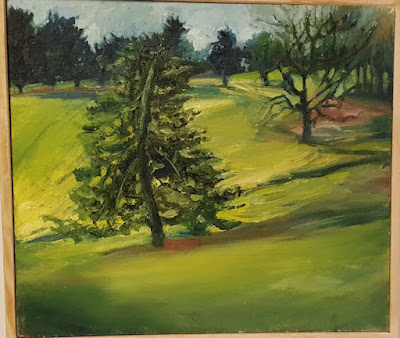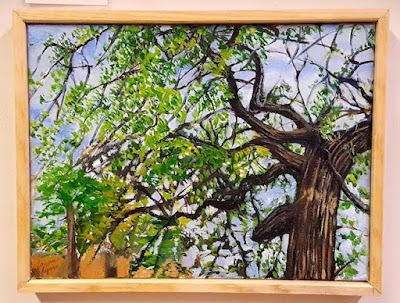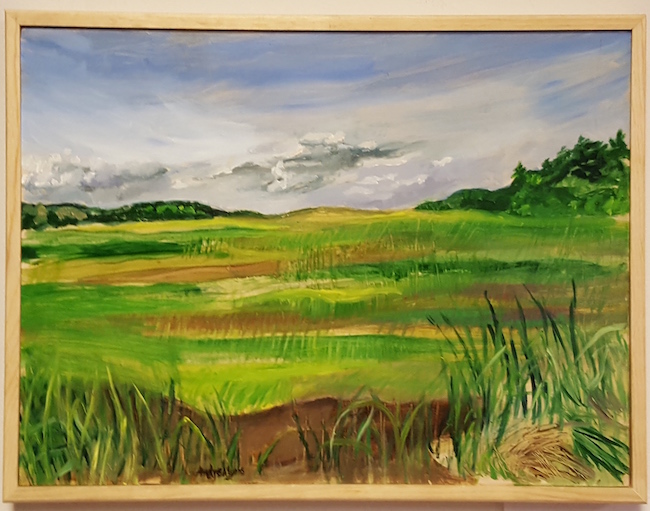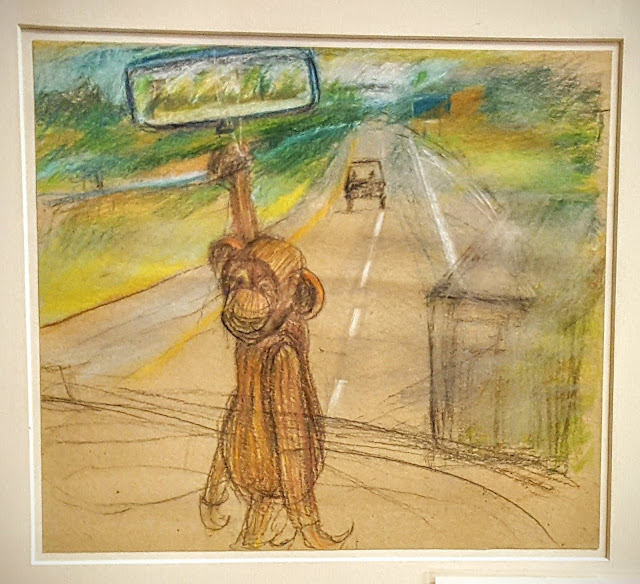Max Hansen Kitchen
Tuesday, December 20, 2016
Wednesday, August 31, 2016
Wednesday, August 17, 2016
Interview with Artist Andrea Lyons
Interview with Andrea Lyons

Commissioned to do a series of paintings this summer in and around the village of Carversville, artist Andrea Lyons works are on display now at the Carversville Grocery. Andrea Lyons trained in art at The Pennsylvania Academy of the Fine Arts and Tyler School of Art and has won awards for her work including a Leeway Foundation grant in painting for women in the arts in 2000 where she was awarded $15,000. Ms. Lyons has painted everything from large public murals to abstract paintings that she describes as being “about the home and the materials that are symbolic of it.” In this interview Andrea Lyons speaks with Max Hansen Caterer’s Philip Stephano about her life in art and how she recently came to discover the village of Carversville.
PS: Are you from this area originally? Where did you come up?
PS: You studied in Philadelphia at the The Pennsylvania Academy of the Fine Arts?
AL: Right. I got my Masters degree in painting there and I got a Bachelors from Tyler School of Art in printmaking.
PS: What I'm seeing at the store is very painterly; it looks like oils and watercolors with fairly loose strokes. Is this a new art form for you or have you always done painting?
AL: I started out in drawing and printmaking. Then I took up painting when I couldn't get access to a printing press. I took up painting. I was still in my twenties then and I've been painting ever since. I've done some painting. I've done some murals around Philadelphia and other types of paintings.
PS: That's interesting. Can you talk a little bit about the murals and how you see the meaning they have for the community?
AL: Many years ago, before Mural Arts came into existence, I did a mural for Bain's Deli and Restaurant which was, at that time, in Suburban Square in Ardmore in the western suburbs of Philadelphia.That's what started my murals. I did one for Bain's (and it was huge!) It took up the whole side of the street. You could see it from the window as you were going down Montgomery Ave.
Many years after that I was on 4th Street on Fabric Row. I was buying some fabric and I was asking the guy about the history of the store there because my mural for Bain had been on 4th and South. It was where the first Bain's restaurant was. So he was telling me about it and I mentioned that I do murals. He asked me if I could do a mural for them on the side of their building for a store called Maxie's Daughter (which still exists). If you go to fabric row off Fourth and Monroe Street you can see that mural. It still exists! It's across the street from Essene, the natural food store.
While I was there, I was painting the mural and I enjoyed that part of the city so much that I decided to move into the building! There was an apartment that became available. So I lived there for a while. I did some other murals. I worked for Mural Arts program and I did some murals for the city- one in West Philadelphia, one in Northeast Philadelphia at the Jardel Playground which was the subject of a documentary on public reaction to public art. The mural got whitewashed. While I was there there were people that came by that said to me, "are those figures African American?" (They used another term) "Are they black or white? " I said, "it doesn't really matter what they are. They are supposed to represent swimmers in a swimming pool." So they said, "if you don't whiten up those swimmers we're going to whitewash that mural." Well I didn't really think they'd do it and so I continued painting. When I was finished they whitewashed the mural. It was the subject of a documentary. For that I got a lot of publicity! (laughing) But it was negative, you know. That wasn't so cool.
PS: How do you translate yourself from those big public murals to what seem to be intimate paintings of landscapes and places?
AL: Well I've been multi-faceted with my art. I've done a really diverse kind of work going from abstracts to sculptural shaped canvases and paintings and all different types of figurative work and different types of work. I just do what I like to do and that's all. I don't really pay attention to if it's the "same type of work" like you're supposed to for galleries (laughing). You’re supposed to do a consistent body of work and I don't really do that. But I do enough landscaping painting because I love working outdoors. I do enough landscaping painting that I have a pretty consistent body of work for the show.
PS: What landscapes attract you locally and elsewhere?
AL: I like hills and I love trees. I try to do that in my landscapes. I don't really get into flowers that much (although I have done some flowers).
PS: Are you painting outdoors or indoors from memory?
AL: I mostly paint outdoors. I mostly do plein air painting. I take my portable easel and wear a hat for the sun!! I love being outside. There are some occasions when I can't do that, when I have to take a photograph and paint indoors. Some of the work that's at the Carversville Grocery is from photographs but most of it is from outside.
PS: Is Bucks County a place that you particularly enjoy painting?
AL: It is a place where I enjoy painting. I discover it every time I go up there. If I'm in an area like Peace Valley Park there are some beautiful spots along the way. Sometimes I just see a spot from the road and I stop and take my easel out and start painting. I know you're supposed to ask people if you can paint there but I don't always do that!
PS: Can we talk a little bit about color? I'm curious to see how color has worked thematically through the printing, the murals, the oil paintings and even the water colors. How does color affect you?
AL: I love color. I initially started out in black and white when I was a printmaker. I started to learn about color when I took up fabric design. I took a course in fabric design and we had to learn about all the different color waves and I would do a pattern in more than one type of color scheme... Of course when I was at Tyler I had this teacher, Richard Cramer, who taught me watercolor in the summertime. I learned a lot from him about color. My other work that I do...that's a shaped piece of wood with someone walking on the beach with water.a There is a lot more work that I do that is similar to that. Some of it is abstract too. Those paintings I often take the grain of the wood and I emphasize the grain of the wood. Sometimes I take complementary colors and I use them in different ways with the grains of wood.
PS: I would like to ask you about line. If you started in printmaking that is very line oriented and now you've branched out to things that are expressive and free from line. Do you have any observations about that?
AL: Line for me works with the kind action I put into it. The activity, the movements that I'm using with my body while I'm painting works in with the lines. So if you see this one print that has a white frame and it's up on the wall. It's called "Long Way Home". It's got a lot of activity, line and motion. It almost feels like finger painting but it's not.
PS: So line is in your actual movement....It's physical and kinetic, not just an idea.
lyons.andrea1947@gmail.com
Sunday, August 14, 2016
Monday, July 11, 2016
Bucks County Artist Smita Rao at the Carversville Grocery
Bucks County landscape artist Smita Rao's work is on display at the Carversville Grocery through the month of July. This fine exhibit features a series of monoprints that capture ethereal moments in time and place. The technique of monoprints is a printing method that involves painting on a plexiglass plate; they are essentially printed paintings. As a result of this method each print is a unique spontaneous expression that combines printmaking, painting and drawing media. The following information is from Smita Rao's website :
"Smita Rao is an award winning Bucks County artist, pioneering use of digital mixed media to create novel artwork to express her love of the local landscape.She has brought the elegance of Fine art to the area of digital Arts.
Smita Rao uses the digital media to overlay, fuse and flatten her photographs, watercolors and drawings to portray the local woods and fields. Through this blend of separate visual expressions she depicts her interpretation of the surrounding landscape.
We know you and your friends and family will enjoy learning more about this talented local artist. See you at the Grocery!
The sensitively rendered landscapes are arresting in their luminous and lush beauty.In a short span of time she has won several awards and has been featured in area art newspaper sections. Her work has been exhibited at numerous major venues, including juried shows at the Woodmere and Berman Museums, the Perkins and Abington Centers, and several galleries. Smita Rao's art has drawn a loyal following. Her work is displayed in private collections, business centers, and public institutions."












Tuesday, March 1, 2016
Help Wanted: Grocery Manager
Help Wanted: Grocery Manager
Max Hansen Carversville Grocery is looking for an experienced, energetic, customer service oriented manager to: - deliver exceptional customer service
- grow sales and control costs
- hire, train and lead an exceptional staff
215-297-5353
Tuesday, February 16, 2016
The Color of Love: An interview with Susan Roseman of Artie Art
"In our life there is a single color, as on an artist's palette,
which provides the meaning of life and art. It is the color of love'.
~Marc Chagall
The Color of Love: An interview with Susan Roseman of Artie Art
INTRO
One constant in her journey is her commitment to giving back to the community. She credits her parents for instilling in her a spirit of volunteerism. Susan’s Artie Art project has supported many dog rescues around the world, most notably our own local Lulu’s Rescue (which features one of Susan’s prints in their logo).
The pursuit of an artist is one that enriches others but Susan and James are also motivated by a desire to give back to the community. Our community has shown that the feeling is mutual. When a fire destroyed Rosemoon Studio in 2005, the response was phenomenal. Susan notes that she and James still have a feeling of indebtedness to all the friends, neighbors, and artists who helped them get through that trying time; a time when they learned about loss but also the love of the community.
In this interview Philip Stephano talks with Susan Roseman about the richness of her life as an artist in Bucks County. Susan’s prints are currently on display at Max Hansen Carversville Grocery through the end of February.
PRINTMAKING
PS: So tell me a little bit about how you came to be working in the printmaking medium...
SR: I was a painter actually and I painted very large. We lived in an apartment and it was hard to paint so I started printmaking but I was also very influenced by a couple of my instructors from college that were graphic teachers. I loved printmaking in college but I was mainly trained as a painter at Pennsylvania Academy of the Fine Arts in Philadelphia.
PS: Is that where you and James met?
SR: No, we met in New Hope at Havana's out on the street.
James Feehan: I was working at Havana's!
PS: What year was that?
SR: 1981
PS: Havana's in '81 was a happening spot!
SR: (laughing) Oh, you betcha!
INSPIRATION
PS: Can you tell us a little about what is inspiring you everyday? Obviously what is around you...
SR: My surroundings, happiness and dogs.
PS: What is it about this area, this studio, this light, this place?
SR: Oh I love this area. I moved to New Hope in '73 and never wanted to leave. We found this place in 1985. We lived in the Laceworks in Lambertville. We actually built the apartment on the third floor. We loved it there. We always wanted kind of a factory building and we saw this building (the studio) for sale. Everybody thought we were crazy (laughing). We bought it. There was the big cinder block building, there was no running water, there was electric, and a porta potty!
SR: And we did have a wonderful studio here. We had a fire and we learned about loss in 2005. I had a lot of blocks that were lost in the fire. You know you are supposed to print your editions;I shouldn't be saying this but I don't. I'm really bad at it. Most of my prints there are maybe just like 4 or 5 of the editions and that's it. But I lost a lot of plates in the fire. But we love this space.
PS: How did the community respond to your loss?
SR: They were beyond amazing. It was ....They went beyond the call of duty. They were unbelievable. We are so grateful for our community and beyond. So then the gallery we had flooded that April of 2006...
PS: Oh God. It sounds like an apocalypse.
SR: Oh, it was...
PS: What was the gallery?
SR: The gallery was Riverbank Arts in Stockton, NJ
PS: So a lot of changes, a lot of challenges but you are still a happy person...
SR: Right, you learn to go along with the journey. Think of it as a journey. Ups and downs.
THE DOGS
PS: Can you speak of some of the constants in your life. I see that there are quite a few changes that you had to go through, what are some of the constants?
SR: Art, really. Art and dogs.
PS: Tell me about the puppies...
SR: I'd always had animals growing up. I loved dogs. We had a great dog, Artie, that's where Artie Art started. Artie actually died a day after the gallery closed.
PS: Oh God, what a horrible time….
SR: IT was pretty bad... and that kind of was the inspiration for Artie Art. Plus I had no idea what I was going to do with my work. I also worked at a couple of restaurants: one that was sold and one that was closed up so I had lost all my jobs. You move on. It was art that saved me and it was inspired by Artie...
PS; Can you remind me of the date as to when that nexus of events happened?
SR: Jan. 1 2012 was when Artie died.
PS: Was Artie a Jack Russell?
SR: He was a rat terrier. Artie was an incredible dog. He had personality. He was yin yang! he had charm. He was a very smart dog. He (laughing)... he was a character...
JF: We loved him.
SR: So that's where all my characters kind of came from for my Artie Art brand was from Artie. We were at the vet. I guess they had to put a muzzle on him and we were at the emergency vet and there are all these people with their dogs. The room is filled. Artie comes out from back with the nurses and he started rubbing his nose in my legs and he was just going "ehh, ehhh, ehhh" (plaintively whining), like he had a hard time, they had to put a muzzle on him and he didn't like it. And everybody in the room started laughing and Artie picked his head up and he went around the room and he went "ehhh, eh, eh eh, ehhhh" He was like, "I need to kvetch. I need to complain. " Fetch, kvetch, whatever! (Laughing).
We have so many stories like that of Artie where he was actually a comedian.
Then I lived with James who wanted to be a comedian in elementary school (laughing).
JF: Oh, you never even knew that till I told ya...
SR: (laughing) That's true. Well, I knew something was funny! (laughing) NO pun intended.
SAINT PECULIAR
SR: I grew up with great parents. I was an only child and my father was a character. James and I called him "Saint Peculiar." He was a saint and he was so peculiar but he was funny. He would be sitting at the dining room table and you would look over and there he's got a suction cup to his forehead! Or my father was the type that he went to a party and he shaved half his mustache off and didn't tell anybody and nobody noticed it until he finally said something. He was a character. I had a lot of characters in my life. I guess that's where they all come from.
I was weaned on volunteering. My parents were big time volunteers.
PS: Where did you grow up?
SR: I grew up in Fox Chase and then moved to the far Northeast of Philly. We'd come out to New Hope on the weekends from high school and always loved it and I knew this is where I wanted to be. It is a special place that we have here. It's truly amazing.
PS: I always think of this place in terms of light and we have so many pleasing parts of the landscape...it's more than that; it's the people.
SR: I think so. Very much so. Somebody said they heard Bucks County and Hunterdon County area is built on a crystal shelf and that's what makes this area so special. Who knows if that's true. I'd like to believe it though. It's kind of nice.
PUPPETS
PS: Is that a sketch for a puppet?
SR: I grew up with puppets, paper dolls, and coloforms. It was Kukla, Fran and Ollie. It was Bertie the Bunyip. You have to be from the tri-state area to know about Bertie the Bunyip. There were puppets everywhere. We would go to the circuses, the sideshows, the fairs. There were always puppets all around. I guess I was smitten with the puppets (laughing). Not with the clowns but with the puppets!
PS: What is it about puppets we just like so much.
SR:They are universal, delightful and storytellers that share.
JF: Klee was a puppeteer...
SR: Oh yes! He did incredible puppets. We have a book of his puppets. (James gets the book)
PS: There was something about them that took you to another world
JF: They are mysterious...
PS: ..and a little bit strange.
JF: Klee was great with the kids. He entertained and would create these theaters. I did a painting once on the idea of one of the puppet theaters.
(Looking at the book together)
PS: Look at this.
SR: Isn't it incredible? His (Klee's) puppets were outrageous. This is the painting James did from that. It's called “Kasperl's Theater.”
PS: There's a little religious iconography there too. There's a painting within a painting. That's cool.
SR: Did you ever look at James' Instagram feed?
PS: We'll look at that later. I want talk about you. You are a hard one to crack because you like to talk about other people (laughing). Tell us about your puppet project...
SR: How did they start? Oh, I know. We kept throwing out sponge brushes (James laughs in the background) and I thought it was so wasteful. So I started making puppets out of them. I start with a sponge brush and I put Reynolds wrap around it and then I tape it. And I tape newspaper and then modge podge I build it up.
PS: That looks like one of James' characters there with the crown...
SR: I made that to look like his piece. So we don't know what to do with these.
PS: Puppet theater!
SR: We don't know where they are going yet. We're thinking of them more sculptural.
PS: Maybe it's dioramas?
SR: Dioramas, that would be kind of cool.
PAPER THINGS
PS: Tell me about these again...
SR: These are for my little surprise packs. I started to make paper goods from my childhood memories from the 50’s. In the 50s everything it seemed was made from paper. We had paper dolls, telescopes and finger puppets. And am now having fun working on puppets with moving parts.I also decorated his party hat.
LULU's RESCUE
PS: Obviously Lulu's Rescue and Artie Art are perfect together...
SR: Well, it's a way I can give to the rescues and I can share my art for the dogs. That's what it is all about. And Lulu's is a great organization.
PS: How long have you been working with them?
SR: I can't remember. I think even before they started (laughing)
PS: Who is it over there who you've know from the beginning?
SR: Michele Armstrong, she's the director of Lulu's. I remember when she first started it but she was always rescuing dogs before she started the organization. Like I said, it's just a way that I can give. I can give of myself and promote their cause. I've been doing it with other rescues. I'm working on a card for a rescue in New Zealand, a "grateful for you" card that they can give to their donors as a "thank you" for donating money. They can use my image for promotions. I'm trying to do more of that. Opening it up. Muttville.org is in San Francisco. I did one recently for Carrie's Rescue in upstate NY. So it's nice to be able to share the images; it's all about the dogs.
THE CARD
PS: Where can we find that?
SR: It's on the website. Let's link it in the blog. We can offer it. We have it for cats and for dogs. And so you have your contact
info on the back. It's really good to have if you're an animal owner.
PS: let me get a little video of the dogs. I think they are part of the inspiration
SR: Yes they are! Very much so. They direct our life..
Subscribe to:
Comments (Atom)






